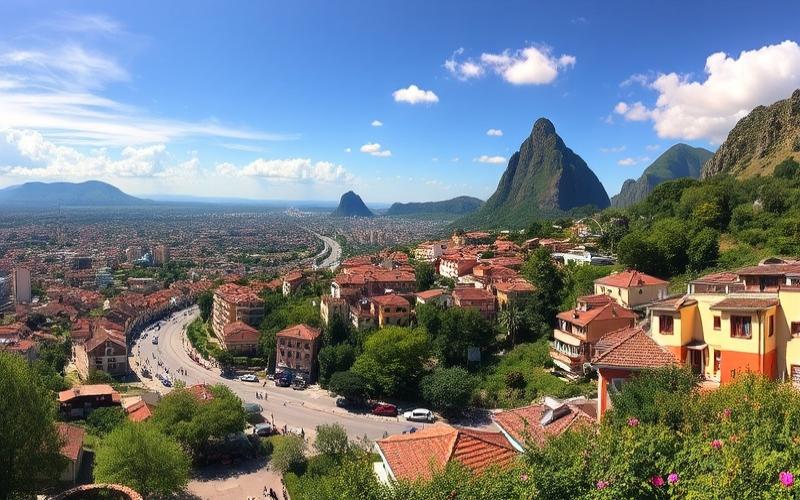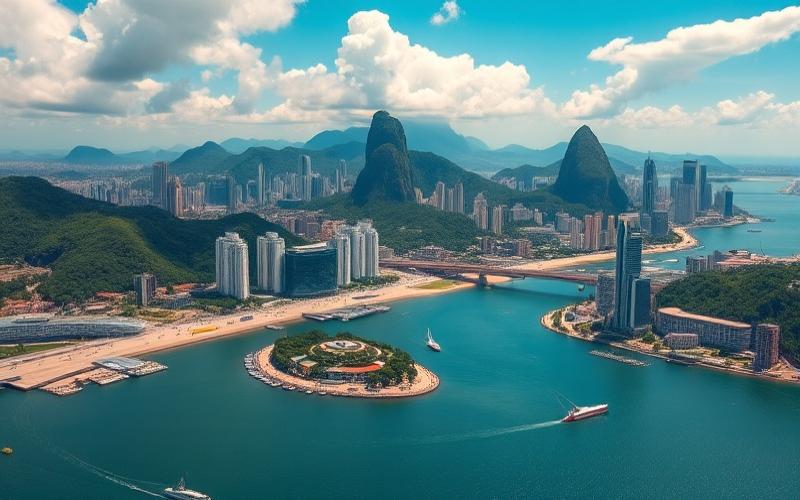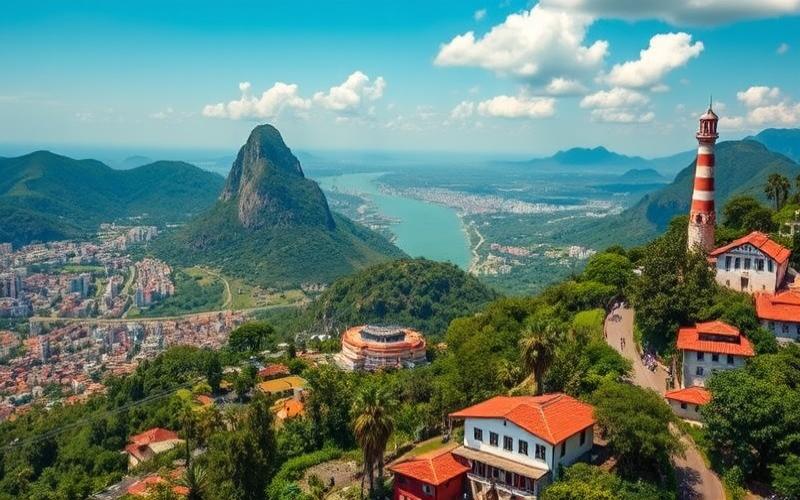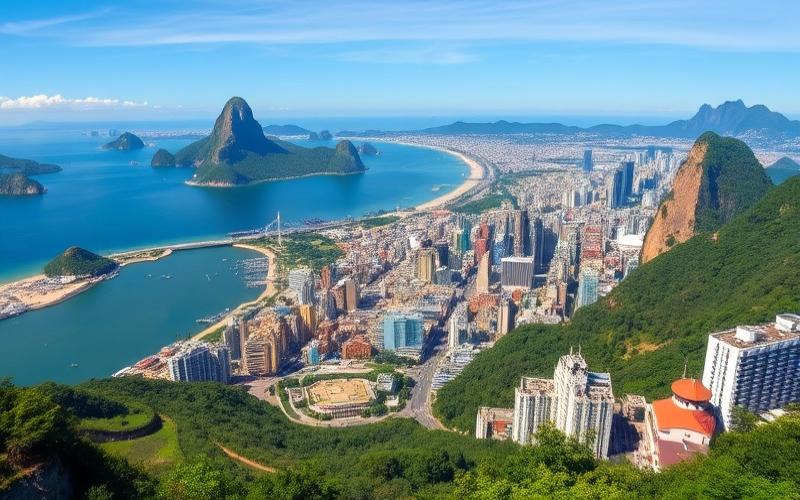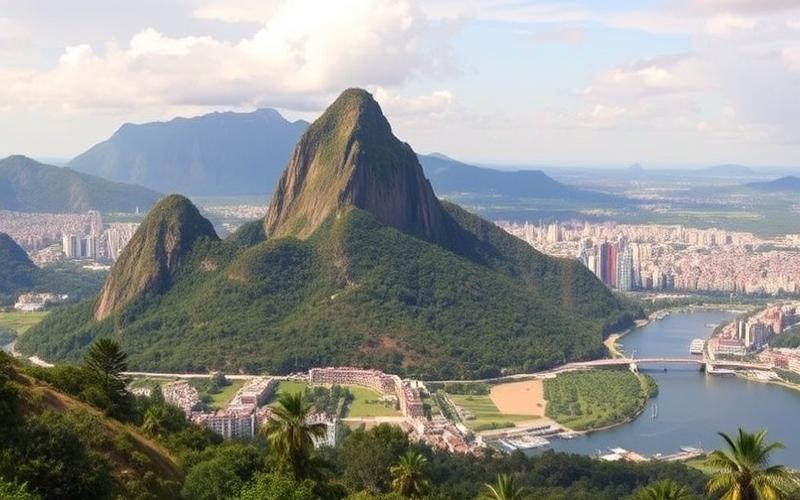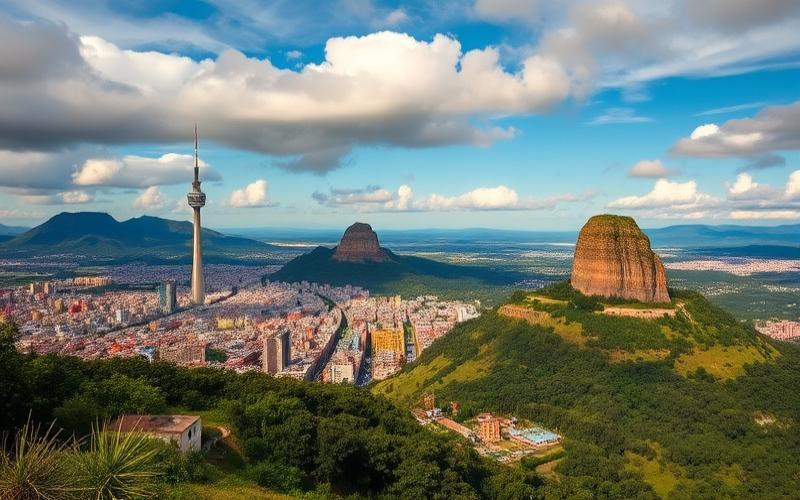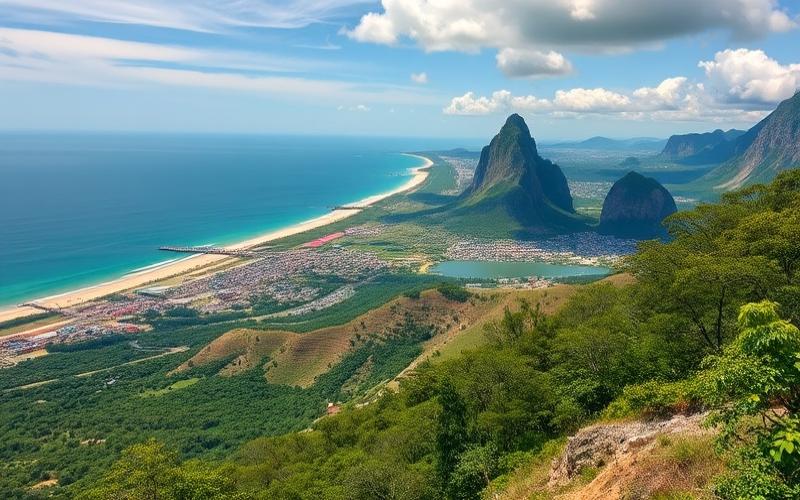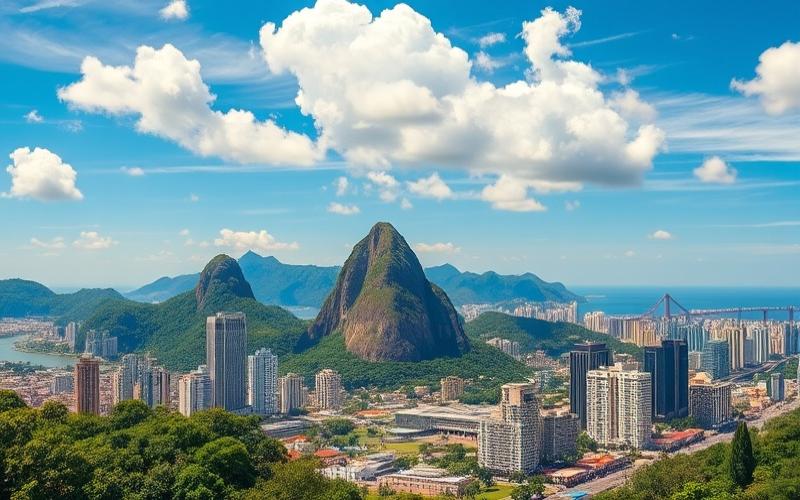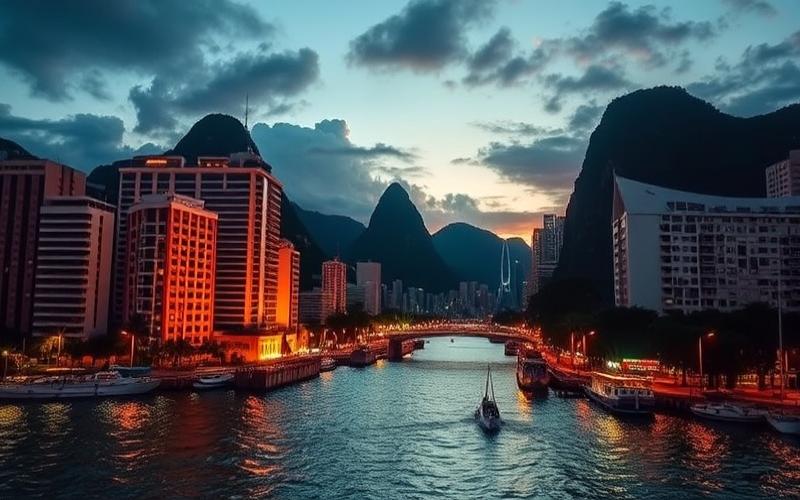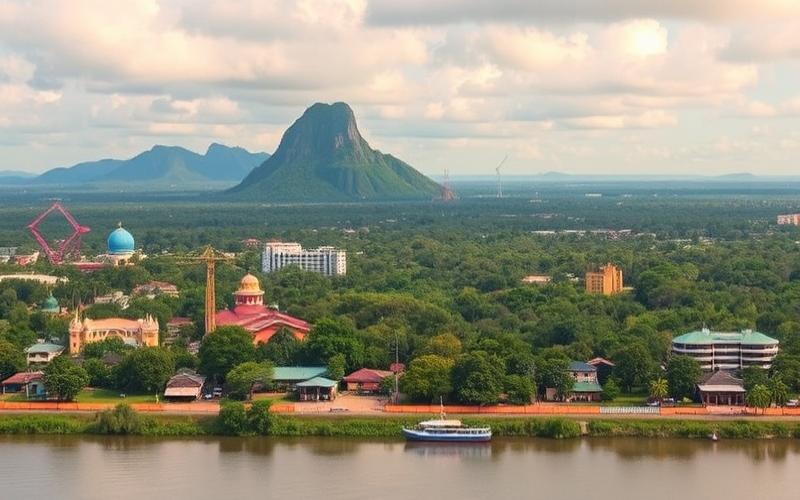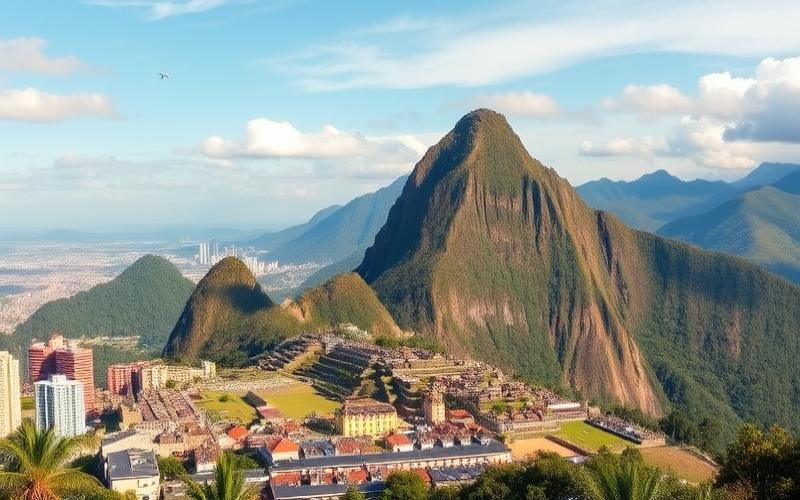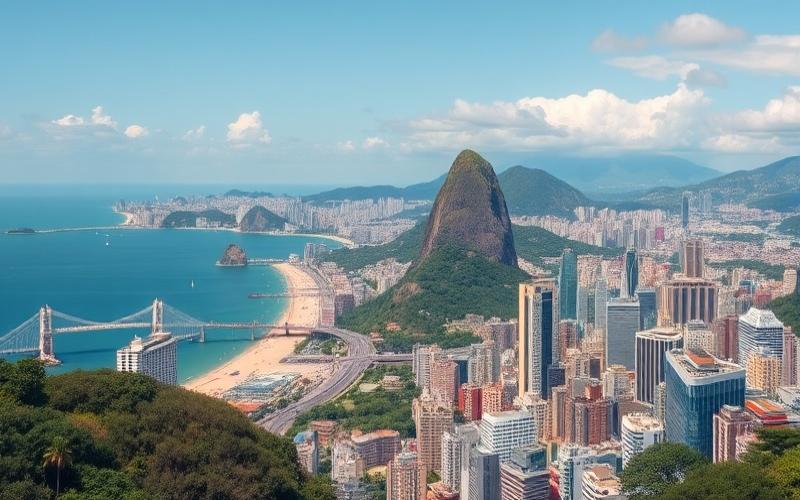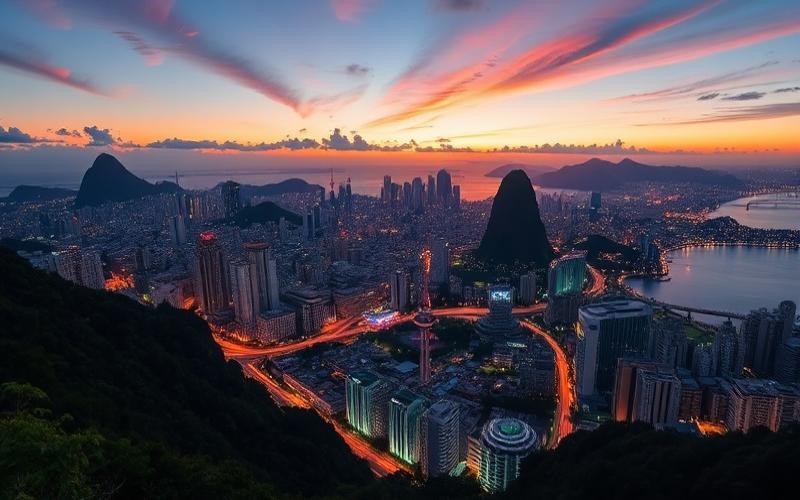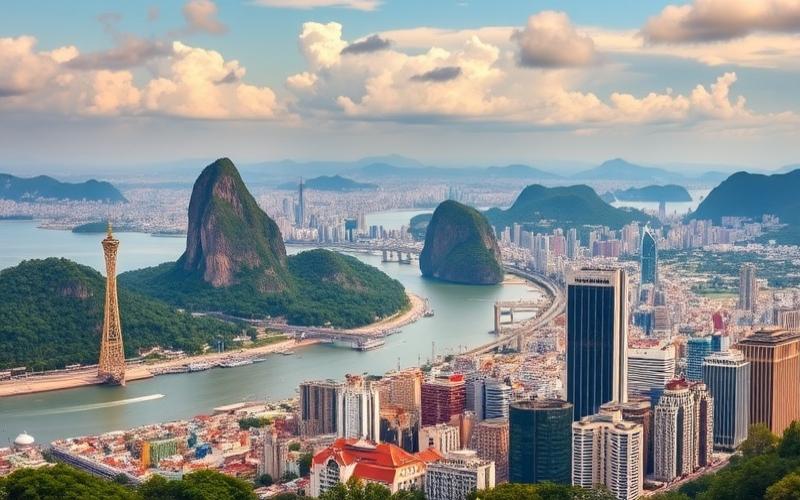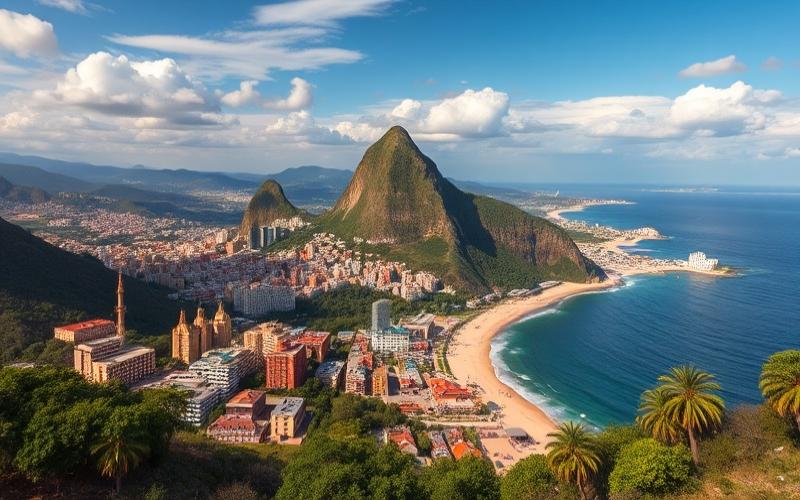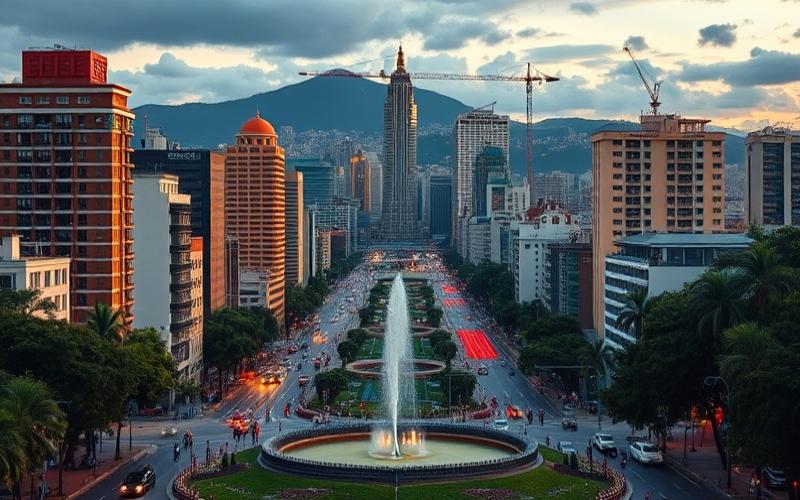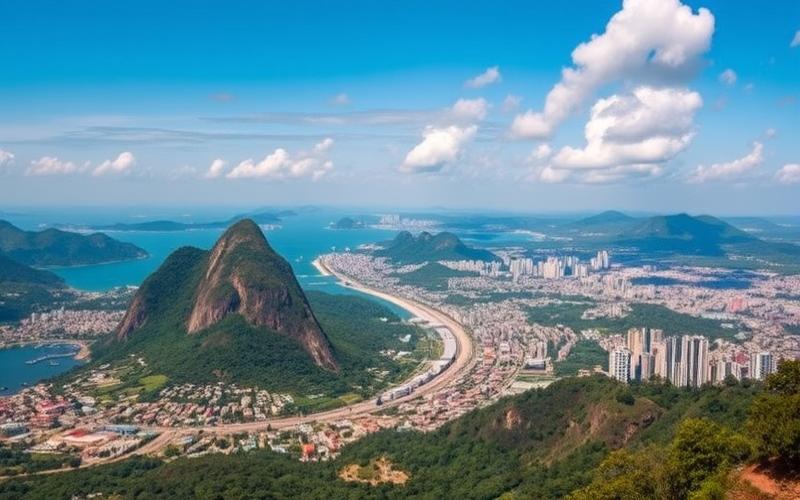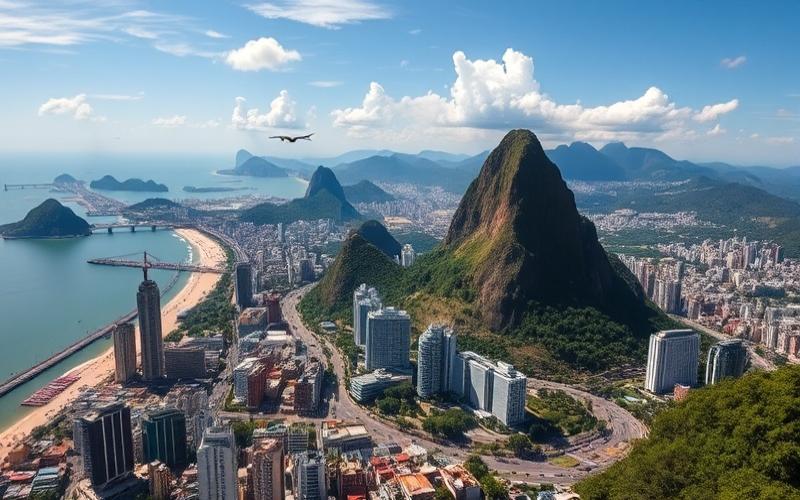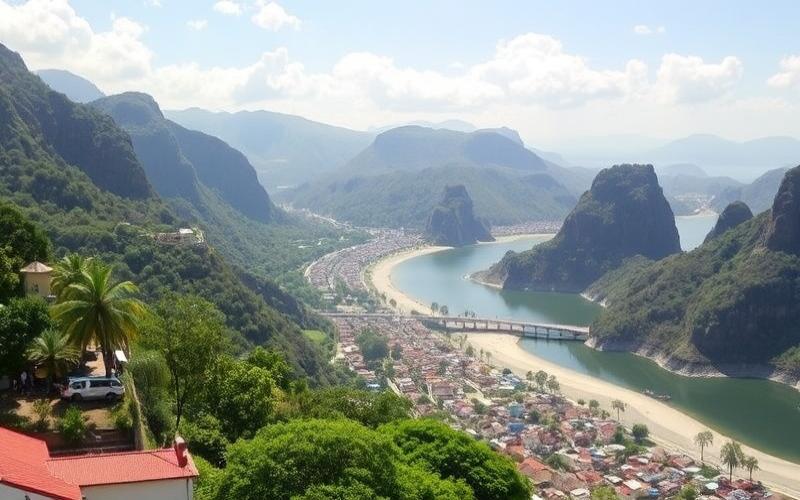
 Published on and written by Cyril Jarnias
Published on and written by Cyril Jarnias
Real Estate in Brazil and the Emergence of “Dark Stores”
Brazil’s real estate market is undergoing an intriguing transformation with the emergence of “dark stores” – warehouses invisible to the public but essential for online commerce.
These discreet spaces, often established in strategic areas of major Brazilian cities, are revolutionizing the supply chain by accelerating order delivery while redefining traditional uses of urban locations.
The rise of this phenomenon demonstrates rapid adaptation to contemporary consumer needs, challenging established economic and spatial structures and raising questions about potential impacts on residential neighborhoods and urban configuration.
Good to know:
“Dark stores” are warehouses dedicated exclusively to preparing online orders, without physical customer service.
Understanding the Dark Store Phenomenon in Brazil
Dark stores are facilities closed to the public, organized as mini urban distribution centers dedicated to preparing and shipping online orders, with targeted assortments and promises of rapid delivery within a few kilometers. In the Brazilian context, they operate as micro hubs networked throughout metropolitan areas (São Paulo, Rio, Belo Horizonte), typically spaced 2 to 5 km apart to optimize coverage and reduce delivery times, often in direct coordination with e-commerce platforms and order management systems.
Operational Functioning in Major Brazilian Cities
- Location in dense areas to maximize customer proximity and delivery frequency within minutes/hours.
- Localized assortment: selection of SKUs according to each urban area’s demand, with frequent restocking and transfers between micro hubs when necessary.
- Technological integration: OMS/ERP and mobile applications, enabling same-day delivery and click & collect where relevant.
- Logistical model: back-office preparation without public access, optimized picking, and handoff to partner delivery services or dedicated fleets.
Economic and Social Factors Driving Proliferation in Brazil
- Acceleration of e-commerce and expectations for express delivery, pushing to bring inventory closer to urban consumers for speed and logistical efficiency.
- Network of micro hubs being less expensive than a single peripheral warehouse for certain categories (groceries, beverages, pharmacy), with favorable trade-offs between targeted urban rents and time savings.
- Venture capital and market share strategies through densification of preparation points, inherited from quick commerce, with prioritization of growth over initial profitability.
- Recurring local demand in high-density, high-purchasing-power pockets, prerequisite for dark store implementation in São Paulo and other state capitals.
Impact of the COVID-19 Pandemic
- Social distancing increased demand for contactless shopping and same-day delivery, making conversions of spaces into dedicated processing points attractive and accelerating model adoption.
- Massive shift of orders to online channels legitimized investment in proximity infrastructure to support service growth and reliability.
Challenges and Controversies in Brazil
- Municipal regulation: hybrid status between commerce and logistics potentially triggering zoning, traffic, and nuisance requirements; activity being closed to public but generating traffic and deliveries, cities question placement in residential or commercial zones.
- Urban space usage: tension on ground floors and commercial spaces reconfigured as warehouses, risking reduced street vibrancy while increasing last-mile delivery movements.
- Competition with traditional retail: speed and logistical proximity advantages potentially shifting demand toward online channels operated from non-public spaces, raising competitive equity and local taxation issues.
- Economic viability: urban fixed costs (rents, labor) and variable costs of rapid delivery requiring high order density; profitability remains sensitive to average basket size and network optimization.
| Element | Potential Benefits | Risks/Constraints |
| Urban proximity | Faster deliveries, customer satisfaction | High rents, regulatory pressure |
| Networked micro hubs | Fine coverage, assortment flexibility | Operational complexity, inter-hub transfers |
| Closed to public | Optimized picking, productivity | Debate on urban vibrancy and zoning |
| E-commerce/OMS integration | Same-day, click & collect | Technological dependency and integration costs |
Future Prospects in Brazil
- Real estate market: conversion of vacant retail spaces into preparation areas should continue in high-density zones, with negotiated rents and more compact formats to improve unit economics.
- Format hybridization: rise of “ship-from-store” models and pickup points, and use of third-party assets (e.g., bars or convenience stores) as local nodes, creating more capillary networks with reduced infrastructure costs.
- Geographic selectivity: deployments concentrated in neighborhoods with high frequency and sufficient average basket size, with 2–5 km spacing adjusted to actual demand.
- Regulatory normalization: expected clarification of municipal frameworks on status, hours, logistical flows, and ground-floor occupancy to reconcile delivery speed and urban quality.
- Profitability orientation: assortment rationalization, picking automation, and delivery pricing targeting economic balance while maintaining speed promise.
Action Lists for Operators
- Map demand by neighborhood and calibrate network spacing at 2–5 km with order density thresholds.
- Integrate robust OMS and standardize multi-hub picking and restocking processes.
- Test local partnerships (bars, stores) as “asset-light” nodes to extend capillarity.
- Early municipal engagement for zoning compliance, hours, and flow management.
| Key Difference | Traditional Store | Dark Store |
| Access | Open to public | No |
| Usage | On-site sales vs preparation | Preparation/delivery |
| Location | Commercial street vs targeted proximity | Customer proximity |
| Timing | Standard vs express | Express/Same-day |
Good to know:
Dark stores, often invisible to consumers, are urban warehouses designed to optimize rapid preparation of online orders, particularly in major Brazilian cities. Their proliferation has been fueled by e-commerce growth during the COVID-19 pandemic, meeting increased demand for home deliveries. However, these structures pose regulatory challenges, as their hybrid nature between commerce and warehouse complicates municipal oversight, impacting urban planning and creating tensions with traditional retailers. As real estate markets and consumer habits evolve toward increased digitalization, dark stores could become essential in optimizing urban supply chains in Brazil, though appropriate regulation is needed to balance innovation and respect for urban spaces.
Impact of Dark Stores on Logistics Real Estate
Dark stores are retail points closed to the public, used exclusively for preparing and collecting/delivering online orders, functioning as micro fulfillment centers close to urban customers. They differ from traditional stores by the absence of public access, organization optimized for picking, intensive use of automation and data, and potentially 24/7 operations, serving e-commerce and quick commerce. Unlike classic stores that display and sell on-site, dark stores operate as proximity warehouses, sometimes converted from retail spaces into depots, and serve click-and-collect and rapid delivery in dense areas.
Main Differences with Traditional Retail Points
- Access: closed to public vs. open to customers.
- Function: online order preparation vs. in-store sales and merchandising.
- Location: discreet/industrial or urban proximity premises vs. visible commercial locations.
- Process: shelving dedicated to picking, automated systems and analytics vs. customer experience-oriented layout.
- Hours: continuous/extended vs. retail business hours.
Recent Trends in Brazil and Sector Dynamics
The model has spread globally from the UK and EU to the Americas, driven by quick commerce growth and pursuit of very short delivery times, a trend Brazil follows in major metropolitan areas (São Paulo, Rio), through densification of urban micro-warehouses for food and consumer goods.
Dark stores deploy by reusing commercial spaces or small urban warehouses, to reduce last-mile distance and support minute-delivery promises, aligning local strategies with practices observed in Europe and the United States.
Quick commerce funding has relied on venture capital, with strong competition and initial losses to gain market share, an economic context influencing site opening/closing pace and local lease negotiations.
Influence on Logistics Real Estate Demand and Prices
Dark store multiplication increases demand for small to medium logistics spaces in city centers and first-ring suburbs, revaluing well-located, modular “last touch” assets.
Key criteria (accessibility, moderate clear height, interior layout possibilities for picking/cold chain, IT capabilities) become rent premium factors for adapted urban micro-warehouses.
Conversion of obsolete retail spaces into dark stores expands potential supply but, in tight markets, scarcity of premises with good logistics characteristics pushes rents and encourages flexible short-term leases with extension options.
Specific Logistics Factors Affected in Brazil
Urban distribution: congestion, parking constraints and traffic restrictions in hyper-centers make proximity to demand basins and micro-sectorization of routes crucial, favoring dense networks of small sites.
Premises accessibility: requirement for docks, utility access, sufficient ceilings, and secure loading areas in tight urban fabrics; conversion of shops into depots requires technical and regulatory adaptations.
Last-mile performance: dark stores serve as nodes for click-and-collect and express delivery, reducing distances and times, but increasing constraints for fine neighborhood placement.
Local Economic and Urban Planning Implications
Economic Effects
- Revitalization of vacant units through conversion into proximity logistics sites, creation of preparation and delivery jobs, and investment flows into alternative urban assets.
- Competitive pressure on traditional neighborhood stores, particularly on commoditized segments deliverable via express.
- Occupancy volatility linked to VC-funded quick commerce cycles, potentially generating tenant turnover and cash-flow uncertainties for owners.
Urban Planning Effects
- Commercial landscape change: “dark” storefronts, increased utility two-wheeler traffic, and logistical use of ground floors, potentially altering street vibrancy.
- Nuisances and regulation: needs for delivery management, extended hours, noise and traffic; foreign cities have responded with zoning, hour regulations and layout requirements, providing references for Brazilian metropolises.
Lessons from International Experience Relevant to Brazil
The model emerged in the UK and spread to France/EU and the United States, showing viability depends on delivery costs, urban density, and local last-mile regulation.
Many international operators pursued growth at the cost of initial losses, highlighting need for rigorous location selection and high picking productivity to achieve economic sustainability.
Conversion of commercial assets into micro-fulfillment has been an effective path to accelerate deployment while optimizing capex, but requires technical adaptations (flows, cold chain, IT) and urban acceptance often conditioned by regulatory safeguards.
Synthetic Comparative Table
| Criterion | Dark Store | Traditional Store |
| Public access | Closed | Open |
| Main function | Online order preparation and delivery | In-person customer sales |
| Typical location | Urban/proximity, converted premises or light warehouses | Visible commercial locations |
| Internal organization | Shelving for picking, automation/IT | Merchandising and customer experience |
| Hours | Extended/24-7 | Standard retail hours |
| E-commerce role | Last-mile node and click-and-collect | Showroom and on-site transaction |
Attention Points for Brazilian Real Estate Players
- Prioritize hyper-close locations to demand with easy logistics access and ability to operate late.
- Evaluate lease flexibility and credit quality of quick commerce operators in consolidation context.
- Integrate technical adaptations (cold chain, fire safety, loading areas) during due diligence of ex-retail premises.
- Anticipate municipal regulatory evolution inspired by European precedents on logistical use of ground floors and nuisance management.
Good to know:
Dark stores, warehouses closed to the public designed to prepare online orders, play a vital role in e-commerce by ensuring rapid and efficient distribution. Unlike traditional stores, they focus exclusively on storage and logistics, disrupting Brazil’s logistics real estate sector. Their growth, particularly in São Paulo and Rio de Janeiro, fuels rising prices for urban logistics spaces, exacerbated by increased demand for accessibility and strategic location to minimize delivery times. This phenomenon, observed in other countries, also brings urban challenges such as increased traffic and neighborhood evolution into logistics zones. Dark stores thus modify the Brazilian real estate landscape by merging corporate real estate needs with urban distribution realities, with significant economic implications for affected areas.
Investments in Dark Stores and the E-commerce Boom
The rapid rise of e-commerce in Brazil has reorganized real estate demand in major urban areas, favoring multiplication of dark stores and proximity micro-hubs to accelerate last-mile delivery. This momentum is driven by massive mobile adoption, instant payments like PIX, and sustained growth of online transactions projected through 2025.
Main Drivers of Dark Store Proliferation:
- Rise of m-commerce (over 97% mobile access) and digital payments, pulling needs for capillary logistics close to consumers.
- Structural acceleration of online sales, with strong expansion prospects in Brazil and shift of purchasing habits toward digital.
- Reconfiguration of growing Brazilian commercial real estate market, offering development opportunities for urban logistics assets.
E-commerce and Retail Players Investing in These Infrastructures:
- National and international e-commerce platforms and marketplaces strengthening urban fulfillment networks to reduce delivery times and last-mile costs.
- Local commercial real estate companies (e.g., developers/managers cited among main Brazilian CRE players) adapting portfolios toward logistics assets and flexible formats, including urban hubs.
Case Studies and Recent Examples
- Urban micro-logistics deployments by e-commerce players to support rapid delivery (same-day/next-day), focusing on state capitals and major metropolitan areas where mobile penetration and instant payments are highest.
- Initiatives by Brazilian commercial real estate investors/managers moving toward logistics segments and flexible formats in response to e-commerce-driven demand.
- 2025 sector trends: integration of social commerce and mobile into distribution strategies, reinforcing need for decentralized execution networks (dark stores) in dense areas.
Challenges for Local Real Estate Sector:
Urban Logistics:
- Limited availability of well-located assets, size constraints, safety and traffic standards for intensive delivery flows.
- Need to adapt existing commercial premises (clear height, van access, loading areas) to light logistics uses.
Urban Regulation:
- Usage permits, nuisances (noise, traffic, hours), and compliance for light storage activities in city centers.
Market and Operations:
- Rent pressure in prime nodes, competition for short flexible leases, and ESG performance imperatives on existing buildings.
Opportunities:
- Repositioning and conversion of obsolete commercial assets into micro-hubs/dark stores to capture last-mile demand in high-density neighborhoods.
- Development of modular multi-site networks, with flexible leases, to optimize urban coverage and reduce delivery times and costs.
- Expected growth of commercial real estate market, supporting value creation through development of urban logistics assets and hybrid retail-logistics formats.
Table — Key Effects of E-commerce Boom on Brazilian Urban Real Estate
| Factor | Real Estate Effect | Implication for Dark Stores |
|---|---|---|
| Mobile/PIX adoption | Increased order volumes and frequency | Densification of proximity micro-hubs |
| Social commerce | Demand dispersion and localized peaks | Need for fine network and operational agility |
| CRE growth | Available capital and appetite for logistics | Development and conversion of urban assets |
Transformation of Traditional Commercial Spaces:
- Conversion of street shops/vacancies and mall units into order execution spaces, click-and-collect, and consolidation points, when physical retail demand is weaker in certain locations.
- Adoption of flexible hybrid formats (showroom + back-of-house stock) to serve both sales and local execution, driven by e-commerce growth.
Good to know:
The rapid rise of online commerce in Brazil has led to proliferation of dark stores, creating notable transformation of urban real estate markets. These urban warehouses emerged through massive investments by major players like iFood and Mercado Libre, seeking to optimize urban logistics. These investments intensified demand for commercial real estate in strategic areas, causing price increases and repurposing of traditional commercial spaces. For example, iFood recently invested in several dark stores in São Paulo to reduce delivery times, illustrating the growing trend. However, this dynamic also creates challenges, particularly regarding urban regulation and logistics, pushing local authorities to adapt legal frameworks to support this new distribution form while ensuring harmonious integration into urban fabric.
Future of Urban Warehouses in Brazil
Urban warehouses in Brazil are entering a phase of structured expansion, driven by e-commerce growth, search for A/A+ assets near consumption centers, and rise of proximity formats like dark stores that reorganize “last mile” demand.
Development Trends in Urban Areas
- Concentration around major metropolitan areas (São Paulo, Rio de Janeiro, Fortaleza, etc.), with rising rents for A+ class assets near capitals, driven by land scarcity and urban logistics demand.
- Supply growth: warehouse stock could expand by approximately 4.9 million m² by 2026, with 2.5 million m² expected in 2025, supporting consolidation of urban and peri-urban hubs.
- Structural vacancy decrease and high net absorption in 2024, validating demand depth and sustainability of new proximity projects.
- Dark stores, as micro-warehouses in urban fabric, reinforce demand polarization toward central and semi-central locations, with impacts on ground-floor commercial/logistical rental values and reconfiguration of space usage.
Impact of Dark Stores on Urban Real Estate Market
- Shift of some demand from classic retail toward light proximity logistics surfaces, aligned with few-hour delivery requirements and “last mile” reliability.
- Upward pressure on well-located rents and land, due to competition between e-commerce, 3PL and quick commerce operators for cross-docking or micro-fulfillment sites.
- Need for flexible, modular and scalable assets, capable of integrating light robotics, picking stations and progressive extensions.
Economic Factors
- E-commerce and 3PL engine: expansion of logistics operations remaining main occupancy driver, well-connected assets capture urban fabric demand.
- Rising rental cycle: average rent increases (R$/m²) since 2020, amplified by INCC, land costs and interest rates, with marked premium for A+ near capitals.
- Supportive macro logistics framework: freight/logistics market growing (CAGR ~4.3% 2024-2029), supported by public infrastructure investments, reducing frictions and encouraging private investment.
Environmental Factors
- Pressure for placements reducing delivery distances, limiting last-mile emissions and favoring efficient buildings (insulation, LED lighting, photovoltaics), consistent with sustainable infrastructure policies and urban modernization.
- Requalification of existing assets in central zones to avoid sprawl, with logistics densification effects and better use of existing networks.
Technological Factors
- Modular automation and scalable robotics (AMR/AGV, goods-to-person) to absorb seasonality and flow unpredictability without initial overinvestment, via incremental robot, rack and workstation additions.
- Digitalization (WMS/OMS, analytics) to optimize urban slotting, order preparation and timing reliability, essential condition for quick commerce.
- Standardization of A/A+ buildings to accommodate automation (clear heights, slabs, energy, connectivity), supporting rent premium of best locations.
Influential Urban Policies and Local Regulations
- Zoning and land use: urban warehouse expansion depends on permits in commercial/light industrial zones and nuisance restrictions (noise, traffic), key in major metropolises.
- Urban heavy vehicle circulation standards and delivery windows, likely increasing interest for transshipment hubs and micro-platforms within urban areas.
- Infrastructure programs and public-private partnerships, with significant annual expenditures through 2025, improving road connections and urban chain resilience.
- Major urban requalification projects potentially integrating logistics/last-mile components and influencing land values (e.g.: central neighborhood revitalization and price increases in renovated areas).
Role of New Technologies (Automation, Robotics)
- Density and productivity gains: goods-to-person systems, modular conveyors and AMRs reduce footprint per order and improve preparation speed.
- Financial scalability: capex in stages through modular systems, limiting risk against urban demand uncertainty and seasonal peaks.
- Operational resilience: software orchestration and robotics to maintain service even under constraints (traffic, hour regulations), competitive advantage for integrated dark stores.
Opportunities for Investors and Developers
- Rental premium on A/A+ assets near capitals and well-located parks, with controlled vacancy and sustained absorption, improving cash-flow visibility.
- Growing supply pipeline through 2026 enabling core-plus and build-to-suit development strategies, particularly in catching-up secondary markets.
- ESG and energy efficiency upgrades as valuation and financing levers, aligned with infrastructure modernization.
Challenges and Risks
- High construction and financing costs (INCC, rates), requiring finer financial engineering and project phasing.
- Intra-urban land and regulatory constraints potentially slowing permits, limiting sizes or regulating logistical flows.
- Quick commerce demand volatility and pressure on dark store unit economics, requiring flexible and reconfigurable assets.
- Increased competition for best locations and possible rent normalization if 2025-2026 supply arrives rapidly in some sub-markets.
How to Anticipate Changing Consumer Needs in Urban Environments
- Proximity and speed: implant micro-hubs and dark stores networked with regional hubs to guarantee same-day/next-day delivery.
- Operational flexibility: prioritize modular and scalable warehouses capable of adding robots and stations according to demand.
- Experience and reliability: invest in software orchestration, data and service quality, reinforced by modernized urban infrastructure.
| Axis | Attention Points | Market Implication |
| Location | Center proximity, road access, traffic restrictions | Rental premium and low vacancy rates on urban A/A+ |
| Product | Clear height, energy resilience, automation | Modular capex and increased productivity |
| Regulation | Zoning, nuisances, delivery windows | Need for micro-hubs and urban transshipment |
| Pipeline | +2.5 Mm² in 2025; +4.9 Mm² by 2026 | Attention to absorption pace and competition |
| Macro/Infra | Public logistics/transport investments | Improved delivery costs and times |
==> To capture urban warehouse and dark store growth, target A/A+ assets near centers, plan modular robotics-compatible designs, integrate ESG and fine urban permit management, and phase deployment according to actual absorption.
Good to know:
The future of urban warehouses in Brazil is strongly influenced by dark store growth, reflecting increasing demand for rapid urban deliveries. Current trends show rising investments in automated logistics infrastructure to meet these needs, with increased robotics integration to optimize operations. However, warehouse expansion is tempered by strict urban regulations and environmental concerns, requiring sustainable strategies aligned with local policies. Investors must be attentive to opportunities offered by emerging technologies while navigating evolving real estate markets. For example, technologies reducing warehouse carbon footprint are increasingly sought, meeting environmentally conscious consumer expectations. Developers must also anticipate necessary adaptations to align with changing consumer expectations, particularly regarding speed and service accessibility.
Disclaimer: The information provided on this website is for informational purposes only and does not constitute financial, legal, or professional advice. We encourage you to consult qualified experts before making any investment, real estate, or expatriation decisions. Although we strive to maintain up-to-date and accurate information, we do not guarantee the completeness, accuracy, or timeliness of the proposed content. As investment and expatriation involve risks, we disclaim any liability for potential losses or damages arising from the use of this site. Your use of this site confirms your acceptance of these terms and your understanding of the associated risks.


